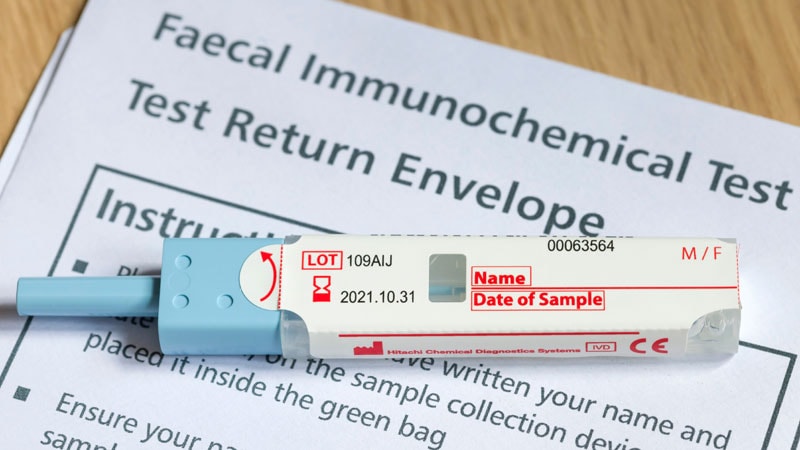Fecal Hemoglobin Concentration in FIT Predicts CRC Risk in Elderly
Temel Kavramlar
Elderly individuals with detectable fecal hemoglobin (f-Hb) concentration in a negative fecal immunochemical test (FIT) are at significantly higher risk of developing colorectal cancer (CRC).
Özet
TOPLINE:
Elderly individuals with detectable f-Hb in a negative FIT have a higher CRC risk.
METHODOLOGY:
Evaluated interval CRC risk based on f-Hb concentration.
Analyzed CRC diagnosis within 24 months of negative FIT.
Used survival and Cox proportional hazards analyses.
Identified stage distribution using logistic regression.
TAKEAWAY:
Study included 305,761 individuals with 661 CRC cases.
Interval CRC risk per 10,000 negative FIT tests was 21.6 overall.
Prior f-HB concentration > 0 μg/g had a higher risk.
Hazard ratio for interval CRC was 4.86 with prior f-Hb concentration.
Odds ratio of advanced stage CRC was 1.45 with prior f-Hb concentration.
IN PRACTICE:
Risk-stratified CRC screening based on f-Hb concentration may prevent CRC cases.
Additional screening for those with detectable f-Hb may be beneficial.
Screening older population has potential harms.
More studies needed to assess harm-benefit ratio.
SOURCE:
Presented at United European Gastroenterology (UEG) Week 2023.
Led by Esther Toes-Zoutendijk, PhD, from ERASMUS MC, University Medical Center Rotterdam.
LIMITATIONS:
No reported limitations by study authors.
DISCLOSURES:
No relevant financial relationships reported.
F-Hb Concentration in FIT May Stratify CRC Risk in Elderly
İstatistikler
Per 10,000 negative FIT tests, the interval CRC risk was 21.6 overall; in those with a prior f-HB concentration > 0 μg/g, it was 65.8 (P < .001).
In those with a prior concentration > 0 μg/g, the hazard ratio for an interval CRC was 4.86 and the odds ratio of advanced stage CRC was 1.45, compared with those without.
Alıntılar
"A risk-stratified upper age limit in CRC screening based on prior f-Hb concentration may prevent CRC cases and CRC-related morbidity."
Önemli Bilgiler Şuradan Elde Edildi
by Becky Mccall : www.medscape.com 10-16-2023
https://www.medscape.com/viewarticle/997424
Daha Derin Sorular
How can the potential harms of screening the older population for CRC be mitigated?
To mitigate the potential harms of screening the older population for CRC, several strategies can be implemented. Firstly, personalized screening approaches based on individual risk factors such as f-Hb concentration can help tailor screening frequency and intensity to those who are most likely to benefit. This targeted approach can reduce unnecessary screenings in low-risk individuals while ensuring high-risk individuals receive appropriate follow-up.
Additionally, educating both healthcare providers and older adults about the benefits and risks of CRC screening is crucial. Clear communication about the potential harms, such as false positives leading to unnecessary invasive procedures or overdiagnosis, can help individuals make informed decisions about screening. Shared decision-making between patients and providers can also help align screening recommendations with individual preferences and values.
Furthermore, continuous monitoring and evaluation of screening programs are essential to assess their effectiveness and identify areas for improvement. Regular review of guidelines based on emerging evidence can help optimize screening strategies and minimize potential harms in the older population.
What are the implications of using f-Hb concentration for risk stratification in other cancer screenings?
The use of f-Hb concentration for risk stratification in CRC screening has significant implications for other cancer screenings. Firstly, it highlights the importance of incorporating biomarkers into screening protocols to improve risk assessment and early detection of cancer. By utilizing specific biomarkers like f-Hb concentration, healthcare providers can identify individuals at higher risk of developing cancer and tailor screening strategies accordingly.
Moreover, the success of using f-Hb concentration in CRC screening may pave the way for similar biomarker-based approaches in other cancer screenings. For example, in breast cancer screening, the incorporation of specific biomarkers could enhance the accuracy of mammography and reduce false positives, leading to more targeted and effective screening programs.
Overall, the findings from using f-Hb concentration for risk stratification in CRC screening underscore the potential benefits of biomarker-based approaches in improving cancer detection and reducing unnecessary procedures in various cancer screening programs.
How can the findings of this study impact current CRC screening guidelines?
The findings of this study have the potential to significantly impact current CRC screening guidelines by advocating for a risk-stratified approach based on f-Hb concentration. Incorporating prior f-Hb concentration into screening guidelines can help identify individuals at higher risk of interval CRC and prioritize them for more intensive surveillance or preventive measures.
Furthermore, the study's results may lead to a reevaluation of the upper age limit for CRC screening, particularly in individuals aged 75 years or older. By considering prior f-Hb concentration in decision-making, screening guidelines can be tailored to the individual's risk profile, potentially improving the effectiveness of CRC screening in older populations.
Overall, the findings of this study may prompt revisions in current CRC screening guidelines to include risk stratification based on f-Hb concentration, ultimately leading to more personalized and effective screening strategies for the prevention and early detection of colorectal cancer.
0
